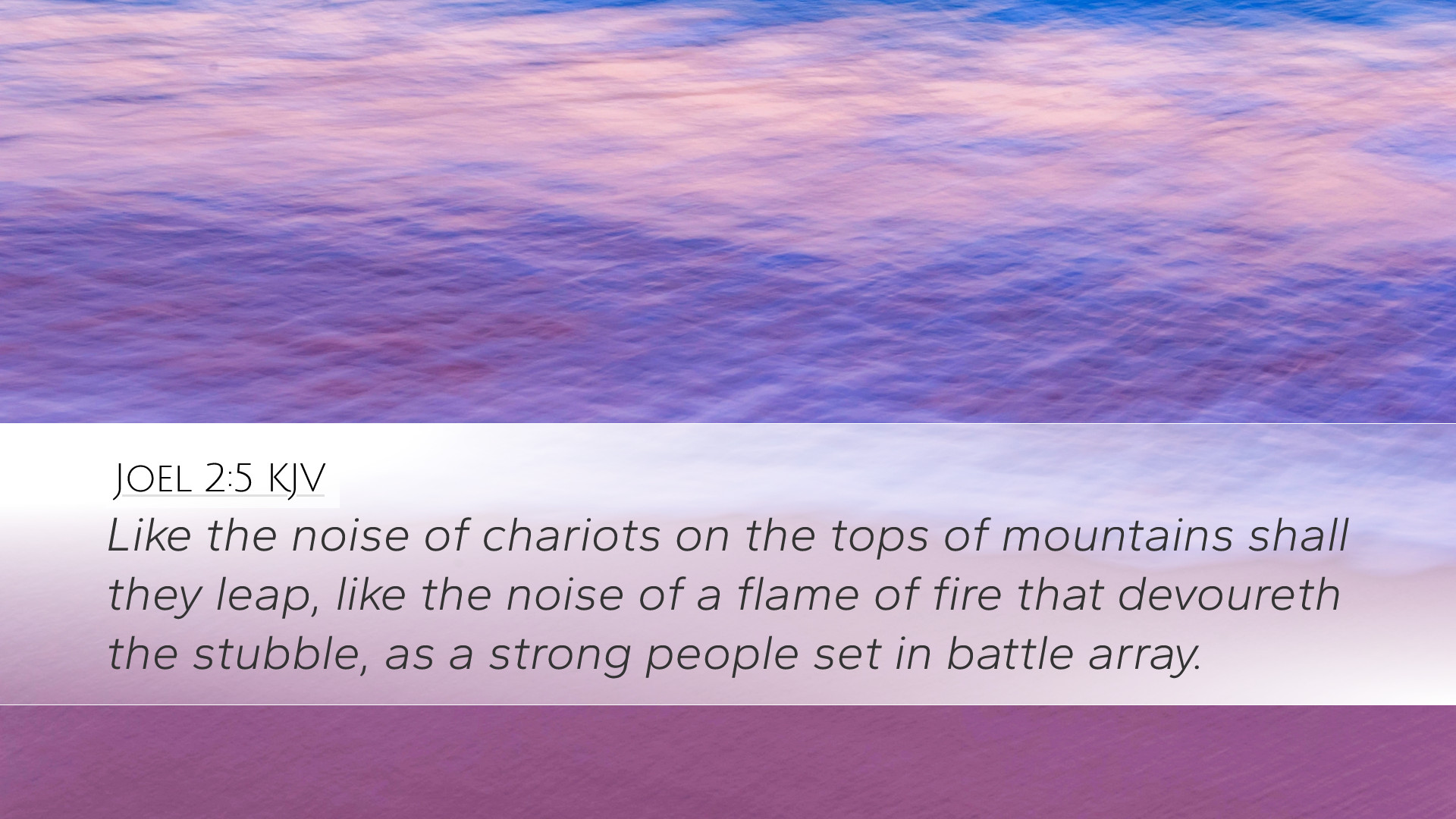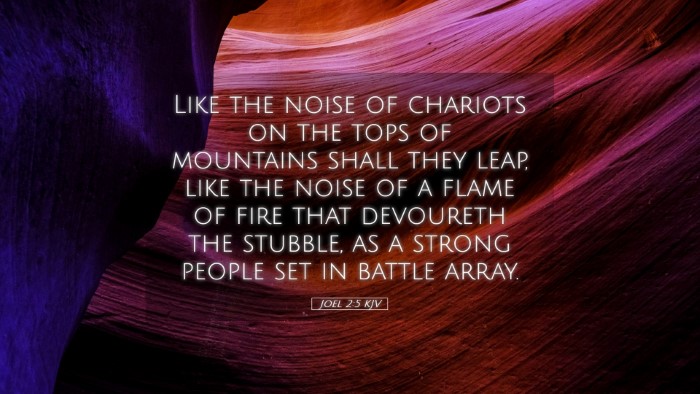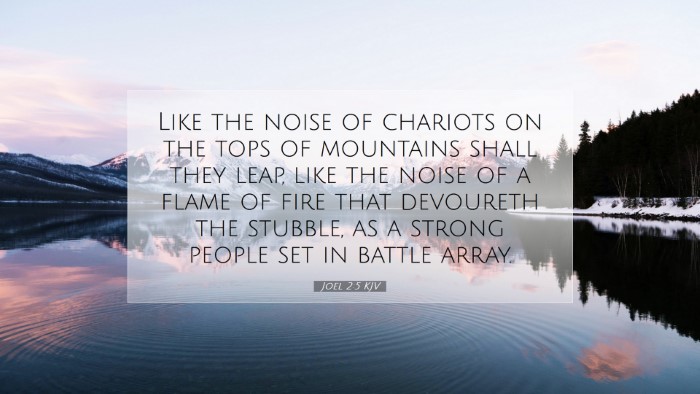Commentary on Joel 2:5
Verse Reference: Joel 2:5 — "As the noise of chariots on the tops of mountains, so shall they leap: like the noise of a flame of fire that devoureth the stubble, as a strong people set in battle array."
Introduction
The book of Joel speaks vividly about the impending judgment of God, employing vivid imagery and metaphors to illustrate the seriousness of sin and the urgency of repentance. In Joel 2:5, the prophet utilizes the striking analogy of war to depict the terror and devastation that will come as a result of divine judgment. Pastoral and scholarly reflection on this verse reveals important insights into the nature of God's intervention in human affairs, underscoring the themes of accountability, divine wrath, and redemptive hope.
Commentary Summary
This commentary synthesizes insights from public domain commentators including Matthew Henry, Albert Barnes, and Adam Clarke, providing a comprehensive understanding of Joel 2:5.
Contextual Overview
Joel's prophecies emerged during a time of national distress in Judah, likely prompted by a locust plague that ravaged the land. This event is both a physical calamity and a spiritual call to arms for the people of Israel to return to God. The imagery in Joel 2:5 is tied to the larger theme of God's judgment, characterized by an imminent invasion or divine army, which serves as a metaphor for the consequences of sin.
Imagery of Chariots and Fire
Matthew Henry's Insights: Henry emphasizes that the sound of chariots represents swift judgment. Chariots were powerful symbols of war that evoked fear in the hearts of those who heard them. The reference to the noise of flame suggests destruction, aligning with God's wrath against sin. The urgency of the moment signals to the people that they must take heed of the approaching destruction.
Albert Barnes' Insights: Barnes elaborates that the comparison to the noise of chariots on the tops of mountains signifies not only the fearsome approach of an invading army but also the high vantage point from which they would be seen and heard. The locusts or invading forces are rapid and overwhelming, bringing devastation akin to that suffered in war. The invocation of fire evokes themes of purification and destruction, further signifying that divine judgment results in a loss of life and livelihood.
Adam Clarke's Insights: Clarke points to the metaphor of a strong people set in battle array. The phrase encapsulates the disciplined and coordinated nature of an army on the move, indicating that God's judgment is not chaotic but purposeful and aimed. Clarke also underscores the notion that God's judgment serves as a catalyst for renewal and repentance, establishing a pathway toward restoration after destruction.
Spiritual Implications
- Awareness of Divine Judgment: This verse calls believers to recognize that divine judgment is real and imminent. The natural response should be one of humility, reflection, and repentance.
- Call to Repentance: The terrifying imagery serves as a reminder for God's people to turn back to Him. It evokes the necessity for a genuine change of heart, aligning with the overall theme of Joel, encouraging national repentance.
- God's Sovereignty: The portrayal of God as a warrior highlights His sovereignty over history and nations. This emphasizes the futility of resisting God's plans, promoting a posture of submission and reverence.
- Hope for Restoration: WhileJoel 2:5 emphasizes judgment, it is essential to remember that judgment is part of God's redemptive plan. After the call to repentance, there is always hope for restoration, portraying God's nature as merciful and loving.
Practical Applications for Ministry
For pastors, students, and theologians, the insights from this verse can be translated into contemporary ministry applications:
- Message Preparation: When preaching on themes of judgment and grace, consider utilizing the imagery in Joel 2:5 to illustrate the seriousness of sin versus the hope found in repentance.
- Counseling Opportunities: Engage congregants in discussions about the consequences of sin, while highlighting the path to redemption. Use the powerful symbols from this verse to encourage honest reflection and spiritual realignment.
- Prayer and Reflection: Foster a culture of prayer that acknowledges the reality of sin and the need for grace. Encourage personal and corporate prayer focused on turning back to God in light of His holiness and righteousness.
Conclusion
Joel 2:5 serves as a profound reminder of the weight of sin and the urgency of repentance. Through vivid imagery and powerful metaphors, the prophet Joel articulates the reality of God’s judgment while simultaneously providing a glimmer of hope for restoration. This passage invites pastoral leaders, students, and scholars to delve deeply into its meanings, applying the insights gleaned not only in personal faith but also in corporate worship and ministry endeavors.


